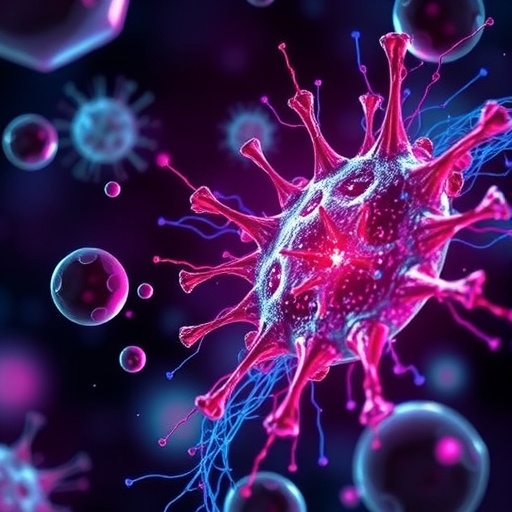A groundbreaking study from The University of Texas at Arlington has unveiled novel insights into the sophisticated mechanisms by which cells regulate their mitochondria during programmed cell death, a vital biological process. This intricate research highlights mitochondria not merely as cellular powerhouses but as active regulators that influence cell fate through calcium ion dynamics, challenging longstanding paradigms within cell biology.
Programmed cell death, or apoptosis, serves as a critical biological safeguard by removing damaged, aged, or superfluous cells, thereby maintaining tissue homeostasis. Failure in this tightly controlled process has severe pathological consequences—cancer emerges when cells evade death, while premature neuronal death is implicated in devastating neurodegenerative diseases such as Alzheimer’s disease. Understanding the molecular interplay that orchestrates this process is therefore of immense biomedical significance.
The study, spearheaded by Rashna Sharmin, a doctoral candidate in Piya Ghose’s lab at UT Arlington, probes the dynamic behavior of mitochondria as cells progress through apoptosis. Leveraging the high spatiotemporal resolution afforded by super-resolution microscopy, Sharmin was able to visualize mitochondrial activity within living nematode cells, providing unprecedented real-time insights into organelle function during cell death.
Contrary to conventional understanding which predominantly views mitochondria as ATP generators, Sharmin’s work reveals a non-canonical protective function whereby mitochondria act as regulators of intracellular calcium concentration. Specifically, mitochondria sequester calcium ions, a pivotal step necessary for the initiation and progression of apoptosis. This calcium buffering capacity essentially modulates localized calcium spikes that could otherwise precipitate premature or aberrant cell death.
The research utilizes the nematode Caenorhabditis elegans as a model organism, renowned for its genetic tractability and cellular transparency, enabling live observation of cellular processes with minimal perturbation. The tail embryonic cells of C. elegans provided an ideal system to monitor the orchestration of mitochondrial transport and calcium dynamics as cells commit to apoptosis, bridging molecular detail with organismal physiology.
One of the study’s defining revelations involves the motor protein kinesin-3, which facilitates the transport of mitochondria within cells. Sharmin demonstrated that kinesin-3-mediated mitochondrial trafficking is integral to suppressing localized calcium spikes, thereby preventing untimely activation of caspase enzymes and specialized apoptotic pathways. This finding posits mitochondrial positioning as a crucial regulatory node in apoptosis.
Further complexity emerged when the role of caspases—proteolytic enzymes central to apoptosis execution—was dissected. Surprisingly, in the absence of a specific caspase, cells exhibited a remarkable capacity to recover from incipient death signals, implying a reversible or abortive phase of apoptosis previously underappreciated. This phenomenon underscores a nuanced layer of regulation governing cellular survival versus death decisions.
The implications of this research extend far beyond basic biology. By elucidating how mitochondrial calcium uptake and transport modulate cell death, this study opens pathways toward novel therapeutic strategies targeting mitochondrial dynamics and calcium signaling. These could prove transformative for treating cancers resistant to apoptosis or neurodegenerative diseases characterized by excessive cell loss.
Piya Ghose, who co-authored the paper, emphasizes that these findings considerably expand the functional repertoire of mitochondria and provide fertile ground for further exploration of cellular recovery and resilience mechanisms in pathological contexts. The interplay between mitochondrial trafficking, calcium homeostasis, and caspase activity represents a frontier in cell death research with vast biomedical ramifications.
Funded by prestigious grants from The Cancer Prevention and Research Institute of Texas and the National Institutes of Health, this study exemplifies cutting-edge interdisciplinary research combining advanced imaging, molecular biology, and genetic tools to unravel fundamental biological enigmas.
Published in the esteemed journal Current Biology, the article titled “Mitochondria transported by Kinesin-3 prevent localized calcium spiking to inhibit caspase-dependent specialized cell death” stands as a landmark contribution to understanding cellular life and death. It not only redefines mitochondrial roles but also opens intriguing questions about the cell’s decision-making machinery at subcellular resolution.
This research underlines the dynamic and multifaceted role of mitochondria far beyond energy metabolism. The ability of mitochondria to modulate calcium signaling and influence caspase activation pathways situates these organelles as master regulators of cellular fate, fundamentally altering perspectives on cell biology and offering hope for innovative treatments targeting mitochondrial dysfunction.
As The University of Texas at Arlington approaches its 130th anniversary, studies like Sharmin’s underscore the institution’s commitment to advancing scientific frontiers. With its impressive research output and resources, UT Arlington continues to contribute profoundly to biomedical science by uncovering the cellular mechanisms that could one day translate into life-saving therapies for complex diseases.
Subject of Research: Not applicable
Article Title: Mitochondria transported by Kinesin-3 prevent localized calcium spiking to inhibit caspase-dependent specialized cell death
News Publication Date: 19-Sep-2025
Web References: 10.1016/j.cub.2025.08.065
References: Published in Current Biology
Image Credits: Credit: UT Arlington
Keywords: Cell biology, Cell identity, Cells, Cell structure, Organelles, Mitochondria




